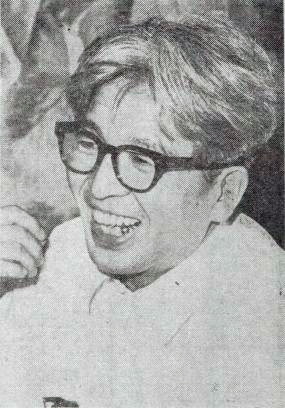Ryōtarō Shiba facts for kids
Quick facts for kids
Ryōtarō Shiba
|
|
|---|---|

Ryōtarō Shiba in 1964
|
|
| Born | August 7, 1923 Osaka, Japan |
| Died | February 12, 1996 (aged 72) Osaka, Japan |
| Occupation | Writer |
| Genre | historical novel, detective fiction |
Teiichi Fukuda (born August 7, 1923 – died February 12, 1996), known as Ryōtarō Shiba, was a famous Japanese author. He was best known for writing exciting stories about Japan's past. He also wrote essays about Japanese culture and how Japan connects with the rest of the world.
Contents
Who Was Ryōtarō Shiba?
Shiba chose his pen name from Sima Qian, a great historian from ancient China. He studied the Mongolian language at Osaka School of Foreign Languages. Later, he became a journalist for the Sankei Shimbun, a major newspaper in Japan.
His Writing Career
After World War II, Shiba started writing historical novels. These are stories based on real events and people from the past. He wrote a lot about the big changes Japan went through during the late Edo period and early Meiji period. These were times when Japan opened up to the world and became more modern.
Shiba was a very busy writer. Many of his books, like Kunitori Monogatari, Ryoma ga Yuku, Moeyo Ken, and Saka no Ue no Kumo, became popular TV shows called Taiga dramas. These shows are often aired for a whole year on NHK television.
He also wrote many essays about his travels. One famous series, Kaidō wo Yuku, was like a journal of his trips across Japan and around the world. People in Japan really liked his unique way of looking at history. Many have read at least one of his books.
Famous Books
Ryōma Goes His Way
One of Shiba's most famous books is Ryōma ga Yuku (Ryōma Goes His Way). It's a historical novel about Sakamoto Ryōma. He was a samurai who played a big part in the Meiji Restoration. This was a time when Japan started to bring in ideas and things from Western countries, which led to huge changes.
The late Edo period was a confusing time in Japan. The country had been closed off from the rest of the world for over 200 years. This was called Sakoku, or national seclusion. The government, led by the Tokugawa clan, decided to open Japan to trade with the United States and European countries.
However, many people disagreed with this. They started a movement called Sonnō-Jōi. This meant "revere the emperor and expel the foreigners." They wanted to fight outsiders and protect Japan from being controlled by other countries. They also wanted to bring back the emperor's power, which the Tokugawa government had taken. This led to a lot of confusion and even fights.
In Ryōma ga Yuku, Sakamoto Ryōma first joins the Sonnō-Jōi group. But he soon realizes that Japan needs to learn from other countries. He saw that Japan was not as strong as Western powers, who had advanced technology and industries. He believed Japan needed to adopt some Western ideas to become an equal nation in the world.
Before this book, Sakamoto Ryōma was not very well known. Ryōma ga Yuku became Shiba's best-selling book in Japanese, selling over 21 million copies!
Kaidō wo Yuku
Kaidō wo Yuku (meaning "On the highways") is a series of travel essays. Shiba wrote these for a weekly magazine from 1971 to 1996. In these essays, he shared his thoughts on the history, geography, and people of the places he visited. Most of the series is about different parts of Japan, but it also includes trips to other countries like China, Korea, Ireland, and New York.
This work was also made into a documentary series shown on NHK, Japan's public TV channel. The series had 1,146 parts!
Clouds Above the Hill
Another very popular book is Saka no Ue no Kumo (Clouds Above the Hill). This is a big historical story about two ambitious brothers, the Akiyama brothers. They came from a small rural area but rose to important positions after the Meiji period began in 1868.
The book shows how the Akiyama brothers worked to build a strong Japanese military. This was important because the region was unstable. The Russo-Japanese War is a key part of the story, showing Japan's fast modernization and rise to power in Asia and the world. This book is Shiba's second best-selling work in Japanese, with over 14 million copies sold.
His Final Days
Ryōtarō Shiba suffered from internal bleeding and fell into a coma on February 10, 1996. He passed away two days later.
Honours and Awards
Shiba received many important awards for his writing:
- Naoki Prize (1960)
- Kikuchi Kan Prize (1966)
- Yomiuri Prize (1981)
- Asahi Prize (1982)
- Person of Cultural Merit (1991)
- Order of Culture (1993)
- Junior Third Rank (1996, given after his death)
See also
- Japanese literature
- Taiga drama
- Ōkunitama Shrine
- In Spanish: Ryōtarō Shiba para niños

